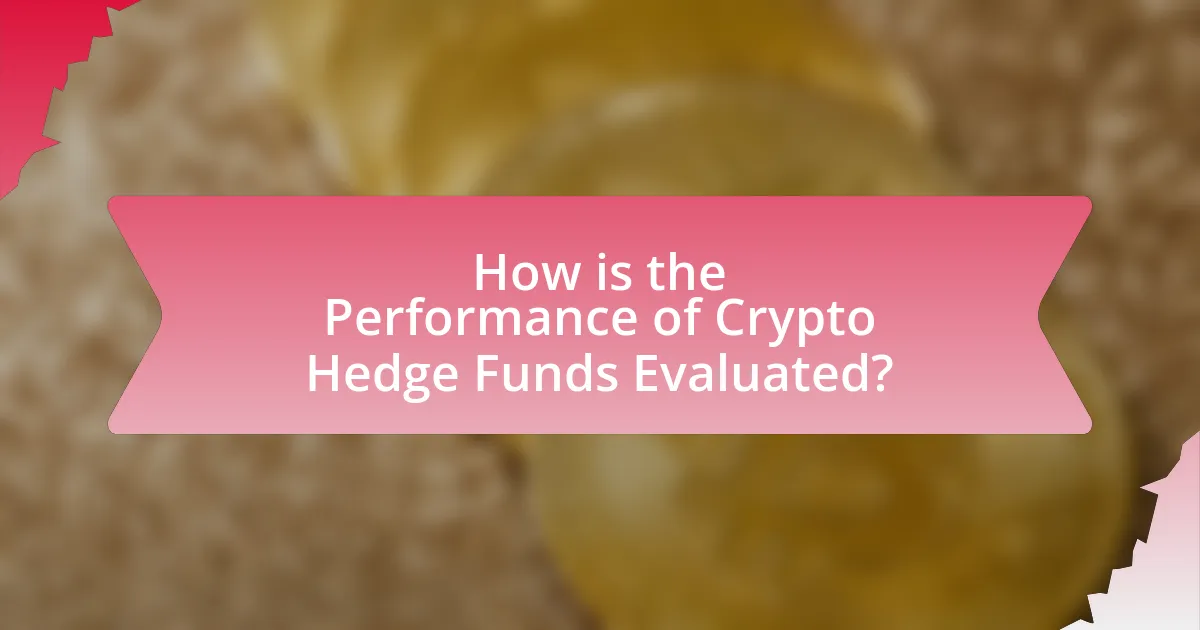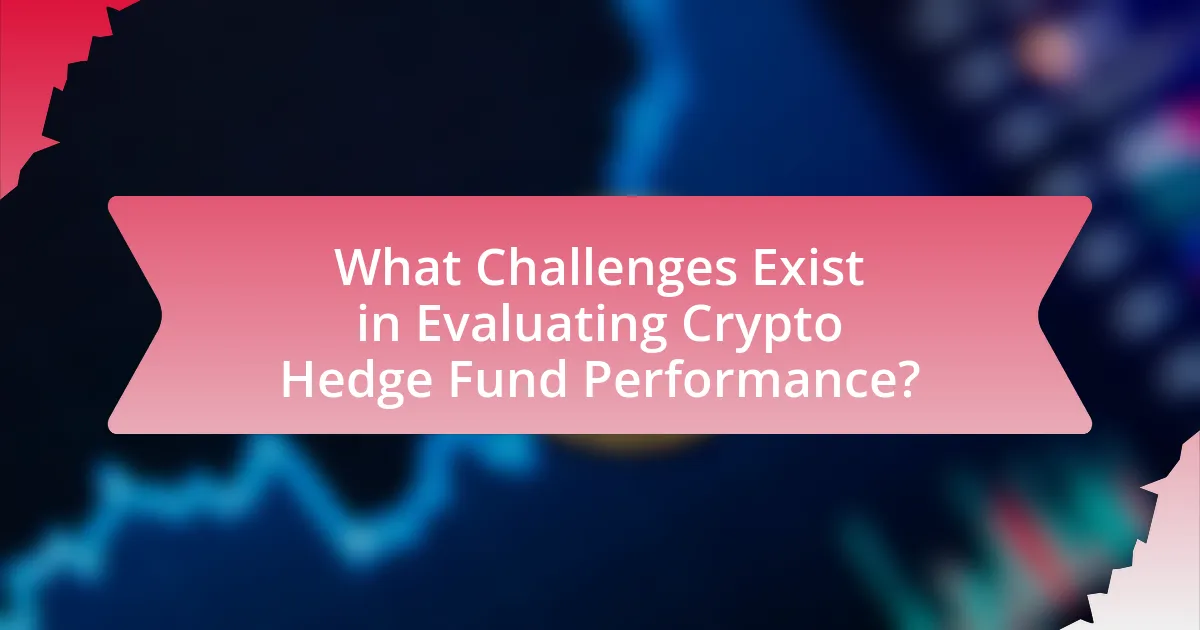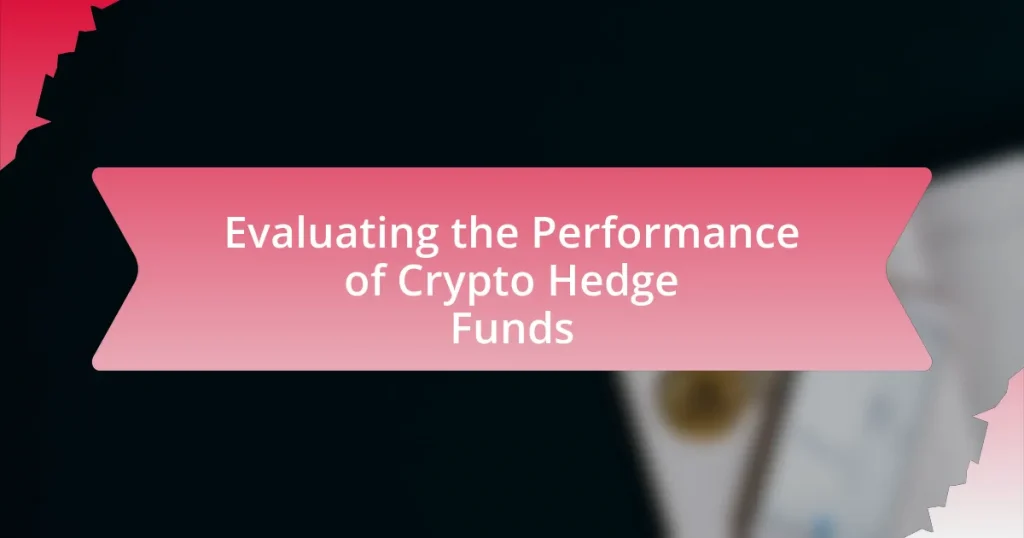Crypto hedge funds are specialized investment funds that focus on trading cryptocurrencies and digital assets, employing various strategies such as long/short equity, arbitrage, and market making to generate returns. The article evaluates the performance of these funds, highlighting key metrics like return on investment (ROI), volatility, and Sharpe ratio, while also discussing the unique challenges posed by the cryptocurrency market, including regulatory changes and market manipulation. Additionally, it examines the growing popularity of crypto hedge funds driven by institutional interest and the evolving regulatory landscape, as well as best practices for investors when assessing fund performance.

What are Crypto Hedge Funds?
Crypto hedge funds are investment funds that primarily focus on trading cryptocurrencies and digital assets. These funds employ various strategies, including long/short equity, arbitrage, and market making, to generate returns for their investors. According to a report by PwC and Elwood Asset Management, the crypto hedge fund industry has seen significant growth, with over 150 funds managing approximately $3.8 billion in assets as of 2021. This growth reflects the increasing interest in cryptocurrencies as an asset class and the potential for high returns, albeit with substantial risks.
How do Crypto Hedge Funds differ from traditional hedge funds?
Crypto hedge funds primarily differ from traditional hedge funds in their investment focus, as they specifically invest in cryptocurrencies and blockchain-related assets, while traditional hedge funds typically invest in stocks, bonds, and other conventional financial instruments. This distinction leads to varying risk profiles; crypto hedge funds often experience higher volatility due to the nascent and speculative nature of the cryptocurrency market, which can result in significant price fluctuations. Additionally, regulatory frameworks for crypto hedge funds are still evolving, creating a different operational landscape compared to the more established regulations governing traditional hedge funds. The performance metrics also differ, as crypto hedge funds may utilize unique strategies such as arbitrage and yield farming, which are not commonly employed in traditional hedge funds.
What investment strategies do Crypto Hedge Funds typically employ?
Crypto hedge funds typically employ strategies such as long/short equity, arbitrage, market making, and quantitative trading. Long/short equity involves taking long positions in undervalued cryptocurrencies while shorting overvalued ones to capitalize on price discrepancies. Arbitrage strategies exploit price differences across various exchanges, allowing funds to profit from inefficiencies in the market. Market making involves providing liquidity by placing buy and sell orders, earning profits from the bid-ask spread. Quantitative trading utilizes algorithms and statistical models to identify trading opportunities based on historical data and market trends. These strategies are supported by the volatile nature of the cryptocurrency market, which offers significant opportunities for profit.
What types of assets do Crypto Hedge Funds invest in?
Crypto hedge funds primarily invest in cryptocurrencies, blockchain-based assets, and digital tokens. These funds often focus on major cryptocurrencies like Bitcoin and Ethereum, as well as altcoins and initial coin offerings (ICOs). Additionally, they may invest in decentralized finance (DeFi) projects, non-fungible tokens (NFTs), and other blockchain-related ventures. The investment strategy typically aims to capitalize on market volatility and emerging trends within the cryptocurrency ecosystem.
Why are Crypto Hedge Funds gaining popularity?
Crypto hedge funds are gaining popularity due to their potential for high returns and the increasing institutional interest in cryptocurrencies. The volatility of the crypto market offers unique opportunities for hedge funds to capitalize on price fluctuations, which can lead to significant profits. According to a report by PwC, 46% of hedge fund managers surveyed in 2021 indicated that they were investing in digital assets, reflecting a growing trend among institutional investors. Additionally, the rise of decentralized finance (DeFi) and innovative trading strategies further attract hedge funds to the crypto space, enhancing their appeal as alternative investment vehicles.
What market trends are driving interest in Crypto Hedge Funds?
Growing institutional adoption and increasing regulatory clarity are the primary market trends driving interest in Crypto Hedge Funds. Institutional investors, including pension funds and family offices, are increasingly allocating capital to cryptocurrencies, seeking diversification and higher returns. According to a report by Fidelity Digital Assets, 36% of institutional investors in the U.S. have invested in digital assets, reflecting a significant shift in market sentiment. Additionally, clearer regulatory frameworks in various jurisdictions are reducing uncertainty, making it easier for hedge funds to operate within legal parameters. This combination of institutional interest and regulatory support is propelling the growth of Crypto Hedge Funds.
How do regulatory changes impact the growth of Crypto Hedge Funds?
Regulatory changes significantly impact the growth of Crypto Hedge Funds by influencing their operational frameworks and investor confidence. For instance, the introduction of clearer regulations can enhance legitimacy, attracting institutional investors who may have previously been hesitant due to uncertainty. According to a report by PwC, 77% of hedge fund managers believe that regulatory clarity is essential for the growth of their funds, indicating that favorable regulations can lead to increased capital inflow. Conversely, stringent regulations can restrict operational flexibility and increase compliance costs, potentially stifling growth. The SEC’s actions in 2021 to clarify the status of cryptocurrencies as securities exemplify how regulatory clarity can either facilitate or hinder the expansion of Crypto Hedge Funds.

How is the Performance of Crypto Hedge Funds Evaluated?
The performance of crypto hedge funds is evaluated primarily through metrics such as return on investment (ROI), volatility, and Sharpe ratio. ROI measures the percentage gain or loss relative to the initial investment, providing a clear indication of profitability. Volatility assesses the degree of variation in the fund’s returns, which is crucial for understanding risk. The Sharpe ratio, calculated by dividing the excess return of the fund over the risk-free rate by its standard deviation, helps investors gauge risk-adjusted performance. These metrics are often compared against benchmarks like Bitcoin or other cryptocurrency indices to contextualize performance within the broader market.
What key performance indicators (KPIs) are used to assess Crypto Hedge Funds?
Key performance indicators (KPIs) used to assess Crypto Hedge Funds include return on investment (ROI), Sharpe ratio, volatility, and maximum drawdown. ROI measures the profitability of the fund relative to its initial investment, providing a clear indication of performance. The Sharpe ratio evaluates risk-adjusted returns, helping investors understand how much excess return is received for the extra volatility endured. Volatility quantifies the degree of variation in the fund’s returns, indicating the level of risk involved. Maximum drawdown assesses the largest peak-to-trough decline in the fund’s value, offering insight into potential losses during adverse market conditions. These KPIs are essential for investors to gauge the effectiveness and risk profile of Crypto Hedge Funds.
How do returns compare to traditional investment benchmarks?
Returns from crypto hedge funds often exceed traditional investment benchmarks, such as the S&P 500, particularly during bullish market conditions. For instance, in 2020, the average return for crypto hedge funds was approximately 130%, while the S&P 500 returned around 16%. This significant difference highlights the potential for higher returns in the cryptocurrency market compared to conventional equities. However, it is essential to note that these returns come with increased volatility and risk, which are characteristic of the crypto market.
What role does volatility play in performance evaluation?
Volatility is a critical factor in performance evaluation as it measures the degree of variation in the price of an asset over time. In the context of crypto hedge funds, high volatility can indicate greater risk, which impacts the risk-adjusted returns that investors expect. For instance, a study by the CFA Institute highlights that performance metrics like the Sharpe ratio incorporate volatility to assess how much excess return is generated for each unit of risk taken. This relationship underscores the importance of understanding volatility when evaluating the effectiveness and stability of investment strategies in the highly fluctuating cryptocurrency market.
What methodologies are used in performance evaluation?
Performance evaluation methodologies for crypto hedge funds include the Sharpe Ratio, Sortino Ratio, and Maximum Drawdown. The Sharpe Ratio measures risk-adjusted return by comparing the fund’s excess return to its volatility, providing insight into performance relative to risk. The Sortino Ratio refines this by focusing only on downside volatility, making it particularly useful for assessing performance in volatile markets like cryptocurrencies. Maximum Drawdown quantifies the largest peak-to-trough decline, offering a clear picture of potential losses during adverse market conditions. These methodologies are widely recognized in finance for their effectiveness in evaluating investment performance, particularly in high-risk environments.
How do quantitative methods differ from qualitative assessments?
Quantitative methods differ from qualitative assessments primarily in their approach to data analysis. Quantitative methods utilize numerical data and statistical techniques to measure and analyze performance, allowing for objective comparisons and trend identification. For instance, in evaluating crypto hedge funds, quantitative methods might involve analyzing historical price data, trading volumes, and performance metrics using algorithms and statistical models. In contrast, qualitative assessments focus on subjective evaluations, such as management expertise, market sentiment, and investment strategies, which are often derived from interviews or case studies. This distinction is crucial, as quantitative methods provide measurable insights, while qualitative assessments offer context and understanding of underlying factors influencing performance.
What tools and software are commonly used for performance analysis?
Commonly used tools and software for performance analysis in evaluating the performance of crypto hedge funds include Bloomberg Terminal, CoinMarketCap, and CryptoCompare. Bloomberg Terminal provides comprehensive financial data and analytics, enabling users to track market trends and performance metrics. CoinMarketCap offers real-time cryptocurrency market capitalization data, allowing for performance benchmarking against various assets. CryptoCompare provides detailed historical data and analytics tools, facilitating in-depth performance analysis of crypto portfolios. These tools are widely recognized in the finance industry for their accuracy and reliability in performance evaluation.

What Challenges Exist in Evaluating Crypto Hedge Fund Performance?
Evaluating crypto hedge fund performance presents several challenges, primarily due to the volatility and lack of standardization in the cryptocurrency market. The extreme price fluctuations of cryptocurrencies can distort performance metrics, making it difficult to assess true fund performance over time. Additionally, the absence of universally accepted benchmarks complicates comparisons between funds, as traditional metrics like Sharpe ratios may not accurately reflect risk-adjusted returns in the crypto space. Furthermore, the limited historical data available for cryptocurrencies hinders the ability to conduct thorough performance analysis, as many funds have only been operational for a short period. These factors collectively create a complex environment for accurately evaluating the performance of crypto hedge funds.
What are the limitations of available data for Crypto Hedge Funds?
The limitations of available data for Crypto Hedge Funds include a lack of standardized reporting, limited historical data, and issues with data accuracy. Many crypto hedge funds do not adhere to uniform reporting standards, making it difficult to compare performance metrics across different funds. Additionally, the relatively short history of cryptocurrency markets means that historical data is often insufficient for robust analysis. Furthermore, the decentralized nature of cryptocurrencies can lead to discrepancies in data accuracy, as some sources may provide unreliable or outdated information. These factors collectively hinder the ability to effectively evaluate the performance of crypto hedge funds.
How does the lack of standardization affect performance metrics?
The lack of standardization negatively impacts performance metrics by creating inconsistencies in measurement and reporting across crypto hedge funds. Without standardized metrics, investors face challenges in comparing fund performance, leading to potential misinterpretations of risk and return. For instance, varying definitions of key performance indicators, such as Sharpe ratios or alpha, can result in misleading evaluations. A study by the CFA Institute highlights that inconsistent reporting practices can obscure true performance, making it difficult for stakeholders to make informed investment decisions.
What impact does market manipulation have on performance evaluation?
Market manipulation significantly distorts performance evaluation by creating artificial price movements that do not reflect true market conditions. This distortion can lead to misleading performance metrics for crypto hedge funds, as manipulated prices may inflate returns or obscure losses. For instance, a study by the University of Technology Sydney found that manipulated trading volumes can misrepresent the liquidity and volatility of cryptocurrencies, ultimately affecting the perceived risk and return profiles of hedge funds. Consequently, performance evaluations based on manipulated data can result in poor investment decisions and misallocation of resources.
How do external factors influence performance assessments?
External factors significantly influence performance assessments by affecting market conditions, investor sentiment, and regulatory environments. For instance, fluctuations in cryptocurrency prices can directly impact the performance metrics of crypto hedge funds, as these funds often rely on the volatility of digital assets for returns. Additionally, macroeconomic factors such as inflation rates and interest rates can alter investor behavior, leading to changes in fund performance. Regulatory changes, such as new laws governing cryptocurrency trading, can also create uncertainty, affecting how hedge funds operate and report their performance. These external influences are critical in shaping the overall assessment of a fund’s effectiveness and success in the crypto market.
What role do market conditions play in the evaluation process?
Market conditions significantly influence the evaluation process of crypto hedge funds by affecting asset prices, volatility, and investor sentiment. During bullish market conditions, hedge funds may demonstrate higher returns due to increased asset valuations, while bearish conditions can lead to losses and heightened risk. For instance, a study by the CFA Institute found that hedge fund performance is closely correlated with market trends, indicating that favorable market conditions can enhance returns, whereas adverse conditions can diminish them. This relationship underscores the necessity for evaluators to consider current market dynamics when assessing the performance and risk profile of crypto hedge funds.
How do geopolitical events affect Crypto Hedge Fund performance?
Geopolitical events significantly impact Crypto Hedge Fund performance by influencing market volatility and investor sentiment. For instance, events such as trade wars, sanctions, or political instability can lead to increased uncertainty, prompting investors to either withdraw from or invest in cryptocurrencies as a hedge against traditional market risks. Historical data shows that during the 2020 U.S. presidential election, Bitcoin’s price surged amid political uncertainty, reflecting how geopolitical factors can drive demand for cryptocurrencies. Additionally, the 2022 Russian invasion of Ukraine led to a spike in crypto trading volumes as individuals sought to protect their assets from local currency devaluation, demonstrating a direct correlation between geopolitical events and hedge fund performance in the crypto space.
What Best Practices Should Investors Follow When Evaluating Crypto Hedge Funds?
Investors should conduct thorough due diligence when evaluating crypto hedge funds. This includes assessing the fund’s track record, understanding the investment strategy, and reviewing the management team’s experience. For instance, a fund with a consistent performance history over multiple market cycles demonstrates reliability, while a clear investment strategy helps investors gauge risk and potential returns. Additionally, examining the qualifications and background of the management team can provide insights into their capability to navigate the volatile crypto market. According to a report by PwC, 77% of hedge funds believe that having a strong governance framework is essential for managing risks effectively, highlighting the importance of governance in the evaluation process.
How can investors effectively analyze performance reports?
Investors can effectively analyze performance reports by focusing on key metrics such as return on investment (ROI), volatility, and risk-adjusted returns. These metrics provide a clear picture of how well a crypto hedge fund is performing relative to its benchmarks and peers. For instance, a study by the CFA Institute highlights that analyzing Sharpe ratios can help investors understand the risk-adjusted performance of their investments, allowing for better comparisons across different funds. Additionally, investors should examine the fund’s historical performance data, management fees, and investment strategies to assess consistency and alignment with their investment goals.
What questions should investors ask fund managers regarding performance metrics?
Investors should ask fund managers about the specific performance metrics used to evaluate the fund’s success, including the fund’s return on investment (ROI), volatility, and Sharpe ratio. These metrics provide insights into how well the fund has performed relative to its risk. For instance, ROI indicates the percentage gain or loss relative to the initial investment, while volatility measures the degree of variation in returns, and the Sharpe ratio assesses risk-adjusted returns. Understanding these metrics helps investors gauge the fund’s performance in the context of market conditions and compare it with benchmarks or peer funds.















